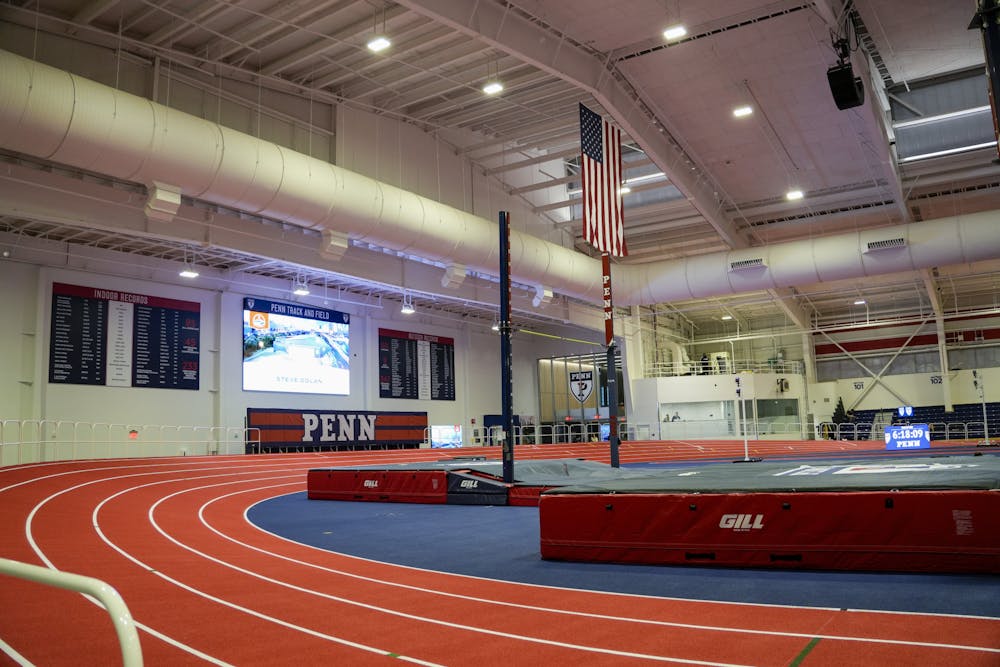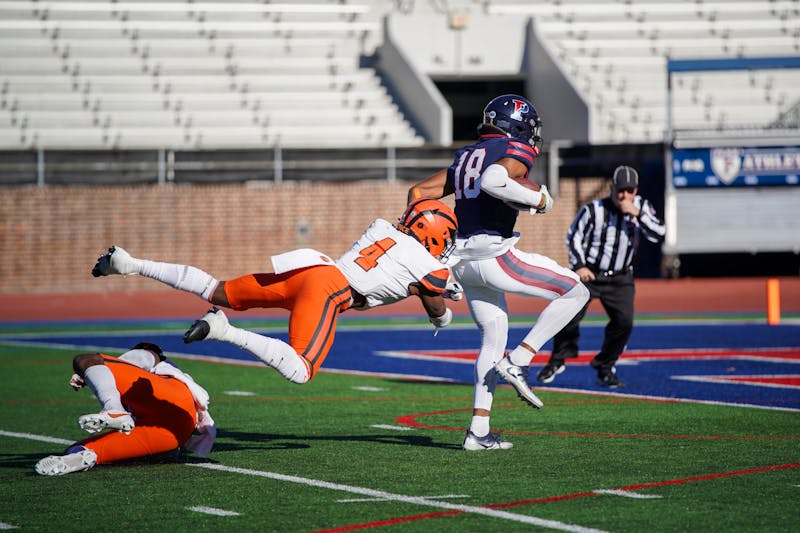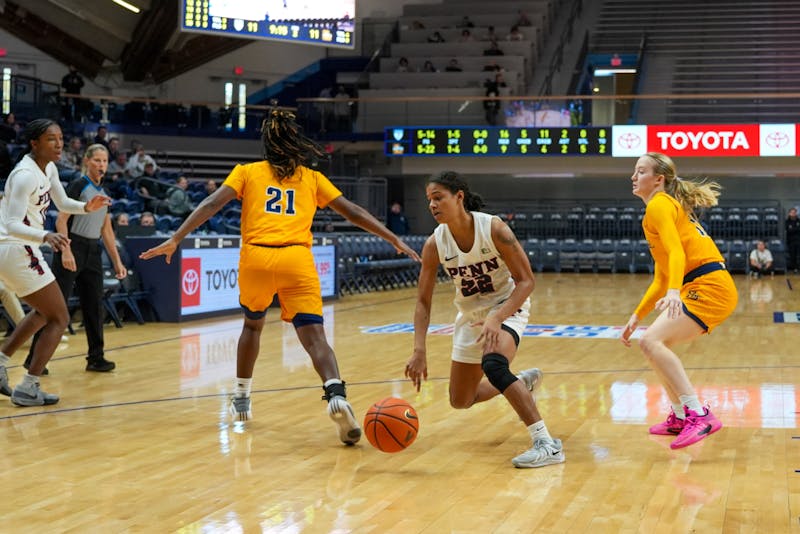
It’s been three and a half months since the Ott Center for Track and Field, Penn’s brand-new, state-of-the-art indoor track and field facility, opened its doors for the first time. In the months that followed, the center has seen records shattered as the Quakers hosted six of their nine season meets thus far within the facility.
The Ott Center, which cost a hefty $69.35 million, is clearly one of many successful projects for the University. But, with donors and administrators only stopping by for the occasional meet, the real reviews come from those who spend the most time in the facility: the track and field athletes, who were more than happy to share their opinions.
“It’s fantastic,” senior thrower Scott Dochat said. “Having a place that is our own, that is [for] Penn track to practice inside, is just such a tremendous upgrade. For our home meets for the last two years, we were going to Staten Island and hosting home meets. So this is a tremendous, tremendous upgrade.”
The current athletes are certainly reaping the benefits of the Ott Center, but the facility was in the works long before they were even born. The promise of a new indoor track center was made as far back as 1970, with the idea taking a concrete shape within the last five to six years. It was used to entice current Penn athletes to attend the University.
“I remember when I was being recruited, that was the selling point,” junior jumper Kampton Kam recalled. “So for it to finally be constructed and we can use it, [is] a blessing.”
The anticipation on the track and field team only grew with time as the center came closer to finishing this past year. Coaches hyped it up and provided the team with regular updates and photos. As news of its completion circulated, chatter among the team increased until their private showing before the official opening.
“Everyone was super excited. I mean, the alums are jealous — it’s ridiculous [for the] seniors that graduated last year,” Kam said. “So it’s just been a long time coming, and there was definitely a lot of anticipation with this indoor facility, not just from us, but from … Penn track alums.”
Without the opportunity to ever compete in the Ott Center, several alumni decided to come back to campus for the Ott Center’s official opening and break in the new track. Dochat recalled that 2023 College graduate and former distance runner Lizzy Bader and 2022 Wharton graduate and former thrower Marc Minichello were among the notable alumni who returned.
Despite spending months practicing and competing in the space, many of the track and field athletes still can’t believe their good fortune in being able to use state-of-the-art equipment every day.
Before the Ott Center was built, the track and field teams practiced in less-than-ideal spaces, which they refer to as “the Annex” and “the Bubble.” The Annex, which, according to Dochat, discolored practice shirts, was demolished so that the Ott Center could be built. Post-Annex, the track team practiced inside a bubble placed on top of the turf soccer field, which was hard on a runner’s body. They also shared the Bubble with many other sports teams at Penn, leading to a lack of space.
The Ott Center is a major upgrade for each event group of the track team compared with these last practice spaces. Within the 73,000-square-foot cavernous dome is a 200-meter banked track — “the highest bank that’s allowed in the NCAA,” according to Kam — two long and triple jump runways and pits, two pole vault runways, an eight-lane infield for sprints, hurdles, and high jump, a separate and enclosed throwing area for shot put and weight throw, and stadium seats capable of seating 1,000 spectators.
The athletes certainly love practicing indoors during the winter and in such a convenient location, but mostly appreciate the efficiency of the Ott Center. Senior jumper Benedikt Sachta commented that having two pits speeds up their practice and allows vaulters to practice taking more jumps.
“The practice just is way more dynamic,” Sachta said. “You’re not just standing there for a while waiting for everyone to take their turn.”
In the past three years, the vaulters have practiced in eight different spaces, according to Sachta, so finally having a permanent place to practice has been incredible. The throwers also now have a caged private space, which allows them to practice safely. Like Sachta, Kam was very glad to have more pits for the jumpers, especially since the ones in the Ott Center are permanently placed.
“Last year … we had to set up every time we wanted to jump with rubber tracks, and then we had to move the pits,” Kam recalled. “And then, for pole vault, we had to do a whole … construction of the runway with the pits. And it was just very time consuming.”
The biggest change as compared with Franklin Field is the banked track. Banking elevates the outer lanes of the track on the curves. Gravity then pulls the runners on the outer lanes inward, allowing them to run faster. Getting used to it can cause some strain on the shins and Achilles tendon, senior sprinter Jocelyn Niemiec noted, but most of the runners enjoy their newfound speed.
Multiple athletes have even noticed improvements in their performance as a result of the new center, Niemiec and Sachta included.
“I have been having a dream season … I [had a personal record] four times out of … the six times I competed there, and … I’m in fourth place on the Penn all-time list right now,” Sachta said. “So I’m super happy about that, but I must say a large part of that … definitely goes to the fact that I have a really good training facility right now.”
Providing the track program with their own space has also resulted in mental benefits in the athletes — specifically, a strong sense of community.
“I can feel that the team has a lot more unity now, because before — especially indoors during the wintertime — I would barely ever see the sprinters … or other event groups practicing,” Sachta reflected. “And now we’re all in the same spot, sharing the same space. So I see the sprinters practicing all the time, the hurdlers [and] the throwers, too, and I just really feel like I’m a part of the team.”
While the Ott Center doesn’t seat as many people as Franklin Field, Dochat chooses to see this as an upside, as it creates a competitive aura for the athletes.
“When we hosted these big home meets this year [and] schools like … Duke, Virginia, Penn State and some of those huge track and field schools are coming, the atmosphere in there was palpable, because everything was tight,” Dochat said. “And honestly, I think it makes for a more electric meet.”
According to Kam, Penn now hosts the “premier [track] facility in the Ivy League,” ultimately providing the program with more opportunities to gain the home field advantage and win more championships.
The Daily Pennsylvanian is an independent, student-run newspaper. Please consider making a donation to support the coverage that shapes the University. Your generosity ensures a future of strong journalism at Penn.
Donate












